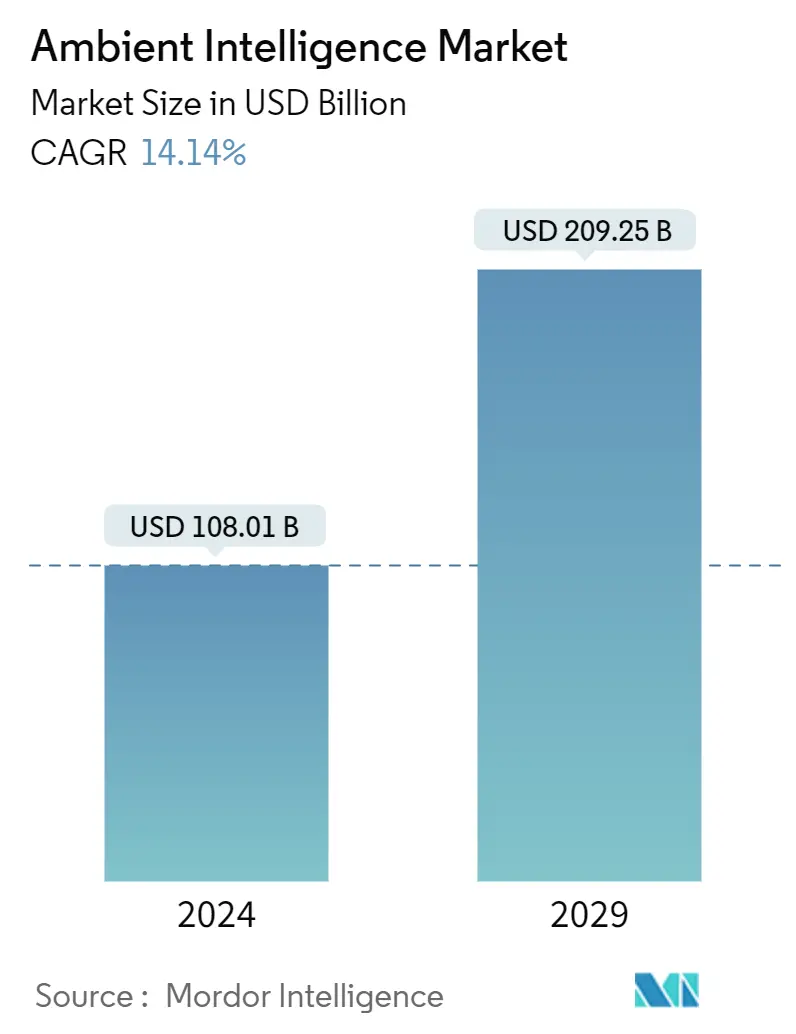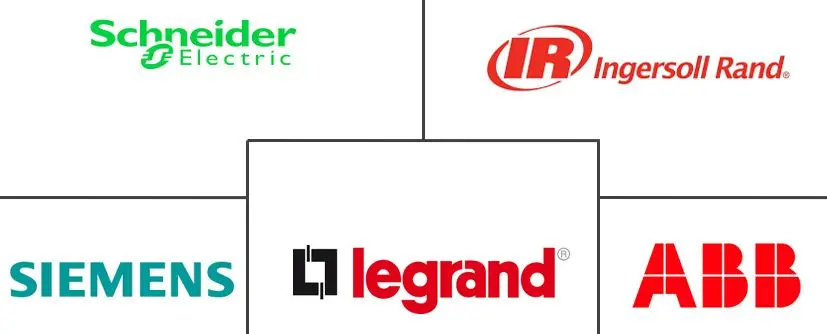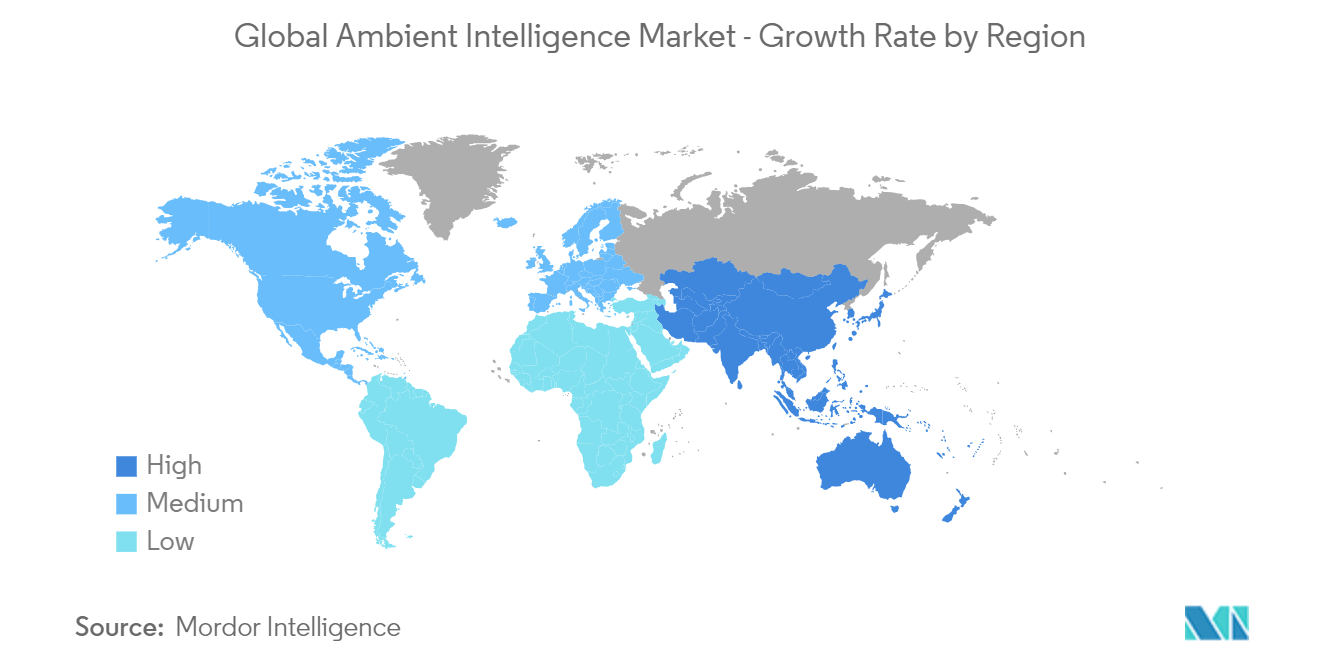Ambient Intelligence Market Size

| Study Period | 2019 - 2029 |
| Market Size (2024) | USD 108.01 Billion |
| Market Size (2029) | USD 209.25 Billion |
| CAGR (2024 - 2029) | 14.14 % |
| Fastest Growing Market | Asia-Pacific |
| Largest Market | North America |
Major Players
*Disclaimer: Major Players sorted in no particular order |
Ambient Intelligence Market Analysis
The Ambient Intelligence Market size is estimated at USD 108.01 billion in 2024, and is expected to reach USD 209.25 billion by 2029, growing at a CAGR of 14.14% during the forecast period (2024-2029).
Ambient intelligence is an emerging multidisciplinary setup environment wherein the solution operates at the nexus of numerous technologies, such as advanced sensor networks, big data, artificial intelligence, pervasive-ubiquitous computing, and human-computer interaction (HCI).
- Ambient intelligence built on ambient computing artificial intelligence (AI) and machine learning (ML) technologies demands a high-performance, efficient architecture that can scale to support devices everywhere to comprehend and anticipate human needs in their surroundings and respond autonomously.
- The increased adoption of smart homes and buildings is one of the main drivers of the market's growth, as smart homes and buildings use ambient intelligence technology to optimize energy consumption, resulting in energy savings and a significant reduction of carbon footprint.
- Using a variety of IoT sensors and devices, ambient intelligence uses intelligent digital systems deployed in homes or workplaces to perceive the surroundings and user context. The Ambient intelligence system then processes the data gathered from these systems.
- The ambient intelligence system analyzes data to determine user proximity, state, intent, and behavior after it has been processed and analyzed. Then, it makes an intuitive decision using insights from the available data, past knowledge, and pattern recognition. Subsequently, it determines the optimal course of action and provides feedback to the user via a natively built, user-friendly smart device interface.
- Businesses and individuals can benefit from ambient intelligence in several ways. Individually, ambient intelligence can make life easier and more comfortable at home by automating routine functions like temperature control and lighting. Ambient intelligence can benefit organizations in many ways, including better customer experiences through customization options, automated procedures that increase efficiency, and enhanced security measures that safeguard occupant safety.
- The development of advanced sensors is expected to fuel the market’s growth, as these sensors enable real-time monitoring of the environment. Also, the increase in investment in IoT and smart city infrastructure by the government and businesses are driving market growth.
- However, as these systems collect and analyze sensitive data, the higher implementation cost and the concern about privacy and security restrain the market growth. Also, the limited awareness of the technology and its benefits limits the market’s growth.
- The emergence of the COVID-19 pandemic had a mixed impact on the market as some sectors accelerated the adoption of ambient intelligence technology while others slowed down the market’s growth. The increased demand for remote monitoring and automation in industries like healthcare, manufacturing, and logistics positively impacted market growth.
Ambient Intelligence Market Trends
Healthcare Segment is Expected to Drive Market Growth
- The healthcare industry has become one of the key drivers of the growth of the ambient intelligence market, as ambient intelligence technology can transform the healthcare sector by improving patient outcomes, reducing costs, and, lastly, enhancing the overall quality of care.
- In countries with a larger population of senior citizens, through Ambient Assisted Living (AAL) technology, ambient intelligence helps older people remotely monitor their health, enabling them to have independent living. Employing this technology will enrich patient experience, physician satisfaction, and quality of care. Thus, the adoption of ambience intelligence solutions is expected to grow in the near future.
- Passive, contactless sensors embedded in the environment can create an ambient intelligence aware of people's movements and adapt to their continuing health needs. This type of ambient intelligence can assist clinicians and in-home caregivers in perfecting the physical motions that comprise modern healthcare's final steps.
- By continuously monitoring patient mobilization, ambient intelligence can help avoid ICU-acquired deficiencies. Healthcare workers might spend less time and experience less mental strain by using sensors and machine learning algorithms to monitor patient’s behavior effortlessly.
- By tracking surgical counts, ambient intelligence technologies can drastically reduce the issues following surgery by preventing things like sponges, needles, and equipment from being inadvertently left within patients. Additionally, these solutions may be able to evaluate surgical skills, which could result in improved training and feedback for working experts.
- The players operating in the market are coming up with technologically extended capabilities for the healthcare sector due to the potential of ambient technology. For instance, in April 2023, 3M Health Information Systems (HIS) partnered with Amazon Web Services (AWS) to accelerate the advancement and innovation of 3M M*Modal ambient intelligence. 3M will use AWS Machine Learning and generative AI services, including Amazon Comprehend Medical, Amazon Transcribe Medical, and Amazon Bedrock, to help expedite, refine, and scale the delivery of its ambient clinical documentation and virtual assistant solutions.
- The continuously increasing healthcare expenditure is also anticipated to fuel the market growth. According to the Centers for Medicare & Medicaid Services (CMS), the U.S. total national health expenditure in 2023 was USD 4,666.3 billion and is expected to reach USD 6,804.2 billion by 2030.

North America is Expected to Hold the Largest Share
- The North American region is expected to hold a significant share of the market studied, owing to factors such as the large number of key players of ambient intelligence vendors in the country, early adoption of advanced technologies, and considerable digitalization across various sectors in the region.
- The increasing demand for smart buildings in the region drives market growth. Rising emphasis on safety and security and growing concerns about energy efficiency and emission reduction are expected to drive growth in smart building demand, creating a need for advanced ambient-assisted technology and boosting market growth in the region.
- The COVID-19 pandemic has accelerated the awareness of ambient intelligence and ubiquitous computing among end users in the United States. It has started adopting ambient intelligence to improve efficiency in daily tasks, assist the healthcare industry with patient care, and reduce manual efforts using AI.
- As witnessed during pandemic times, a hospital may have a small number of physicians and nurses qualified to perform patient diagnostics and tests. Therefore, if more people are visiting hospitals, they will have to wait for their turn outside a doctor's office while a nurse or doctor examines and tests a patient inside. Hospitals can perform initial testing on patients on their own with the help of ambient intelligence tools. An ambient intelligence sensor uses dynamic vitals monitoring to keep a check on the health status of a patient while they wait.
- In addition, its primary application in smart homes mainly drives the demand for ambient intelligence in this region. For instance, as per a case study, the tiny solar-powered house called North House was built to be net zero to produce at least as much energy as it uses amid the harsh Canadian environment. All included were complex, tailored energy systems, intelligent building envelope technologies that adapt customized lighting and climate control systems, and automated optimization behavior. North House’s control system made use of a number of intelligently functioning, optimized subsystems, most notably solar tracking exterior shades that provided effective heating and cooling.

Ambient Intelligence Industry Overview
The Global Ambient Intelligence Market is fragmented, with many players present. Some major players, including Schneider Electric S.E., Ingersoll-Rand PLC, Legrand SA, Siemens AG, ABB Group, and Honeywell International Inc., are adopting strategies for developing the market, like new product development, global expansion, acquisitions, and investments.
- June 2023 - Augnito, an innovative Voice AI solutions provider, launched ambient technology to the global healthcare market. The ambient technology and generative artificial intelligence capabilities will automate administrative tasks, transform clinical documentation, and empower physicians with high efficiency and accuracy. Augnito's ambient technology enables physicians to document patient encounters, generate documentation & data effortlessly, and tackle the pressing issue of physician burnout.
- February 2024 - One of the Leading providers of AI-driven medical documentation solutions, DeepScribe, unveiled its new trust and safety suite. The advanced capabilities of DeepScribe‘s most recent ambient AI technology upgrade demonstrate the company's commitment to establishing industry norms for safety ethics and transparency in AI in healthcare and to ensuring its reliability.
Ambient Intelligence Market Leaders
-
Schneider Electric S.E.
-
Ingersoll-Rand PLC
-
Legrand SA
-
Siemens AG
-
ABB Group
*Disclaimer: Major Players sorted in no particular order

Ambient Intelligence Market News
- February 2023 - Ambient clinical intelligence using AI drastically decreased administrative burdens, restoring quality of life and the joy of practicing medicine and parallelly improving care delivery. In healthcare, it is helping in efficient diagnosis, monitoring patients, detecting and predicting illness, accelerating drug development, improving the patient experience, and expanding access to care. The Nuance Dragon Ambient eXperience is an AI-powered, voice-enabled ACI solution that automatically documents accurate patient encounters and efficient point-of-care.
- March 2023 - Ambient.ai announced the launch of its AI-powered forensics solution to power near-real-time incident investigations. New entity and event-based search capabilities allow teams to search by objects, complex behaviors, and non-biometric person identifiers such as shirt color – reducing investigation times by over 90%.
- April 2023 - Care.ai and Google Cloud partnered to expand the use of revolutionary ambient monitoring solutions in health systems. The technology of care.ai transforms care environments, including nursing homes and hospitals, by building adaptable buildings that enhance clinical and operational workflows and tackle some of the most critical problems in healthcare.
- October 2023 - The innovative cloud-based healthcare technology provider NextGen Healthcare Inc. announced the release of NextGen ambient assist, a real-time ambient listening solution that summarizes appointments and documents care plans at high speeds. For the convenience of providers, ambient assist inserts AI-generated subjective, objective assessment and plan (SOAP) comments straight into the Electronic Health Record (EHR).
Ambient Intelligence Market Report - Table of Contents
1. INTRODUCTION
- 1.1 Study Assumptions and Market Definition
- 1.2 Scope of the Study
2. RESEARCH METHODOLOGY
3. EXECUTIVE SUMMARY
4. MARKET INSIGHTS
- 4.1 Market Overview
-
4.2 Industry Attractiveness - Porter's Five Forces Analysis
- 4.2.1 Bargaining Power of Suppliers
- 4.2.2 Bargaining Power of Consumers
- 4.2.3 Threat of New Entrants
- 4.2.4 Threat of Substitute Products and Services
- 4.2.5 Intensity of Competitive Rivalry
- 4.3 Industry Value Chain Analysis
- 4.4 Product Life Cycle Analysis
- 4.5 Customer Acceptance/Adaptability
- 4.6 Comparative Analysis
- 4.7 Investment Scenario
- 4.8 Assessment of the Impact of COVID-19 on the Market
5. MARKET DYNAMICS
-
5.1 Market Drivers
- 5.1.1 Ubiquity of AI and IoT devices
- 5.1.2 Evolving Location-based Mobile Applications
- 5.1.3 Growing Smart Cities and Smart Home Projects Across the World
-
5.2 Market Challenges
- 5.2.1 Data Security, Privacy, and Identity Issues
- 5.2.2 Lack of Awareness Among Smaller Enterprises
- 5.3 Market Trends
- 5.4 Recent Innovations and Product Developments
6. MARKET SEGMENTATION
-
6.1 By Component
- 6.1.1 Hardware
- 6.1.2 Software and Solutions
-
6.2 By Technology
- 6.2.1 Bluetooth Low Energy
- 6.2.2 RFID
- 6.2.3 Sensors Ambient Light Sensor
- 6.2.4 Software Agents
- 6.2.5 Affective Computing
- 6.2.6 Nanotechnology
- 6.2.7 Biometrics
- 6.2.8 Other Technologies
-
6.3 By End-user Industry
- 6.3.1 Residential
- 6.3.2 Retail
- 6.3.3 Healthcare
- 6.3.4 Industrial
- 6.3.5 Office Building
- 6.3.6 Automotive
- 6.3.7 Other End-user Industries
-
6.4 By Geography
- 6.4.1 North America
- 6.4.2 Europe
- 6.4.3 Asia-Pacific
- 6.4.4 Latin America
- 6.4.5 Middle East & Africa
7. COMPETITIVE LANDSCAPE
-
7.1 Company Profiles
- 7.1.1 Schneider Electric SE
- 7.1.2 Ingersoll-Rand PLC
- 7.1.3 Legrand SA
- 7.1.4 Siemens AG
- 7.1.5 ABB Group
- 7.1.6 Honeywell International Inc.
- 7.1.7 Tunstall Healthcare Ltd
- 7.1.8 Koninklijke Philips NV
- 7.1.9 Chubb Community Care
- 7.1.10 Caretech AB
- 7.1.11 Assisted Living Technologies Inc.
- 7.1.12 Getemed Medizin-Und Informationstechnik AG
- 7.1.13 Medic4all Group
- 7.1.14 Telbios
- 7.1.15 Televic NV
- 7.1.16 Vitaphone GmbH
- *List Not Exhaustive
8. INVESTMENT ANALYSIS
9. FUTURE OF THE MARKET
** Subject To AvailablityAmbient Intelligence Industry Segmentation
The ambient intelligence (AmI) concept was introduced by the European Commission's Information Society Technologies Advisory Group (ISTAG), which refers to a digital environment that proactively and sensibly supports users in their daily routines. The concept of AmI provides a vision of the information society, emphasizing greater user-friendliness, more efficient service support, user empowerment, and support for human interactions.
The ambient intelligence market is segmented by component (hardware and software & solutions), technology (Bluetooth low energy, RFID, sensors ambient light sensor, software agents, affective computing, nanotechnology, biometrics, and other technologies), end-user industry (residential, retail, healthcare, industrial, office building, automotive and other end-user industries), geography (North America, Europe, Asia-Pacific, Latin America, Middle East and Africa). The market sizes and forecasts are provided in terms of value (USD) for all the above segments.
| By Component | Hardware |
| Software and Solutions | |
| By Technology | Bluetooth Low Energy |
| RFID | |
| Sensors Ambient Light Sensor | |
| Software Agents | |
| Affective Computing | |
| Nanotechnology | |
| Biometrics | |
| Other Technologies | |
| By End-user Industry | Residential |
| Retail | |
| Healthcare | |
| Industrial | |
| Office Building | |
| Automotive | |
| Other End-user Industries | |
| By Geography | North America |
| Europe | |
| Asia-Pacific | |
| Latin America | |
| Middle East & Africa |
Ambient Intelligence Market Research FAQs
How big is the Ambient Intelligence Market?
The Ambient Intelligence Market size is expected to reach USD 108.01 billion in 2024 and grow at a CAGR of 14.14% to reach USD 209.25 billion by 2029.
What is the current Ambient Intelligence Market size?
In 2024, the Ambient Intelligence Market size is expected to reach USD 108.01 billion.
Who are the key players in Ambient Intelligence Market?
Schneider Electric S.E., Ingersoll-Rand PLC, Legrand SA, Siemens AG and ABB Group are the major companies operating in the Ambient Intelligence Market.
Which is the fastest growing region in Ambient Intelligence Market?
Asia-Pacific is estimated to grow at the highest CAGR over the forecast period (2024-2029).
Which region has the biggest share in Ambient Intelligence Market?
In 2024, the North America accounts for the largest market share in Ambient Intelligence Market.
What years does this Ambient Intelligence Market cover, and what was the market size in 2023?
In 2023, the Ambient Intelligence Market size was estimated at USD 92.74 billion. The report covers the Ambient Intelligence Market historical market size for years: 2019, 2020, 2021, 2022 and 2023. The report also forecasts the Ambient Intelligence Market size for years: 2024, 2025, 2026, 2027, 2028 and 2029.
Ambient Intelligence Industry Report
Statistics for the 2024 Ambient Intelligence market share, size and revenue growth rate, created by Mordor Intelligence™ Industry Reports. Ambient Intelligence analysis includes a market forecast outlook 2029 and historical overview. Get a sample of this industry analysis as a free report PDF download.



